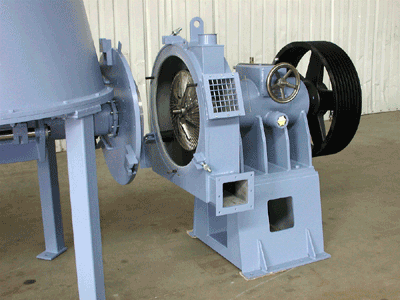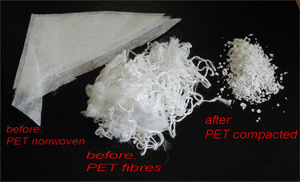|
The HERBOLD Plastcompactor - State of the art and outlook
Karlheinz Herbold, Herbold Meckesheim GmbH
The HERBOLD Plastcompactor is a system, which has been developed originally, to convert scrap with poor flow characteristics (film, fibres, foam, powder) to agglomerated particles with high bulk density. Beside of this job, more application fields are now available and described in this article.
1. Process Description

This is the basic layout of a Plastcompactor system (Picture: Compactor with compactor discs):
after having passed the material through a granulator, a blower brings the material to a buffer silo. A screw feeder feeds the compactor. With a central blower the agglomerated particles are fed in a secondary granulator. The particles are finally transported via a blower, and a fines separator eliminates the fine particles, which are re-fed in the process.
This is the basic principle or the heart of the plastcompactor:
Between a static and a rotating disc, which is equipped with kneating bars, the necessary friction is created. Product is fed via a screw feeder , which is overload-controlled and acting as a discharge conveyor of the buffer silo.
The material to be processed is sintered due to the friction, and leaving the gap between the rotating and the static disc as "noodles". This hot, agglomerated material is then fed to a secondary granulator, the hot melt granulator to cut down to a uniform particle shape. Fines are separated and re-fed into the process automatically.
The final product is a free-flowing compacted material with a high bulk density.
The advantages of the HERBOLD-Plastcompactor compared to all the other agglomeration systems and to recycling extruders is the low temperature of the process. Because the melting temperature is not reached during the process, thermal degradation is a minimum. Therefore, the HERBOLD-Plastcompactor is ideally suited for heat sensitive materials like PET and PA.
2. Applications
2.1 Compacting of PET and PA film

For the reprocessing of thin PET and PA film, the HERBOLD-Plastcompactor is a very attractive alternative to a recycling extruder. There is a win-win scenario:
Beside of the improving of the flow-characteristics, the compactor does the crystallisation of the material at the same time. Without loss of quality, the material can be re-fed into the extrusion process. Typical applications are the in-line reprocessing of thin film for manufacturing of BO-PET, BO-PA, and cast film lines for thin film of A-PET, PET-G, and GAG-PET.
Tests did show a degradation of the iV (intrensic viscosity) of less than 0,02.
The system can be integrated in automatic edge trim recycling lines, and there is the possibility to add off-spec film rolls and loose film at the same time.
Some alternative solutions how to integrate the Plastcompactor in cast film lines:
The increasing amount of cleaned PET bottles has widened this area of application for the Plastcompactor. The clean, dry flakes are processed through the Plastcompactor and either used for manufacturing of packaging tapes, or replacing virgin material in cast film lines, without the need of additional crystallisation.
2.2 Dryer for cleaned film polyolefin flakes
Due to the continuous reduction of the thickness of packaging film, conventional drying systems in washing lines cannot cope any more. If film is less than 50 microns in thickness, it is a problem in mechanical centrifuges to separate the humidity by centrifugal forces. The additional need of thermal heat in thermal drying systems is not economic, due to the high amount of energy required.
The HERBOLD Plastcompactor is the right answer to this problem and a very efficient module for drying of film flakes. Either the thermal dryer is replaced or supported by the Plastcompactor and flakes are leaving the process in hot, dried shape, and if the Plastcompactor is operated with a narrow gap between the discs the material is even agglomerated at the same time. High bulk density and good flow characteristics are essential for homogenisation of big portions in front of the recycling extruder, for example if the amount of stretch film can vary in the infeed material stock.
2.3 Compounding
The Plastcompactor is designed to put additives in. This is done in a by-pass at the end of the feeding screw, where for example masterbatch can be dosed into the product stream.
Another field of application is the recycling of carpet waste, especially in the automotive industry. To convert fibres into free-flowing agglomerate is the key process for a simple, cheap way of reprocessing carpet waste into the product stream.
One more example is the manufacturing of composite materials: it is possible to add fibres and wood flour with high percentages to scrap or virgin pellets.
3. Available model sizes, characteristics and advantages of the process
The HERBOLD-Plastcompactor is manufactured in 3 basic sizes with 300, 500 and 700 mm disc diameter. The capacity can vary from 100 to 1800 kg/hr. The required main drive motor size is 45 to 250 kW.
HERBOLD did invest a lot of effort in the automisation of the process. Now a fully automatic system is available, due to precise measurement of the temperature in the compaction zone, without the need of manual readjustment during operation.
Low investment costs, automatic operation and low operation costs, compared to recycling extruders, are the main advantages of this system.
A compactor HV 50 is available in the HERBOLD showroom for testing.
Herbold Meckesheim GmbH
Industriestr. 33
74909 Meckesheim, Germany
Phone: +49 (0) 6226 932-0
Fax: +49 (0) 6226 932-495
Email: Herbold@Herbold.com
Internet: www.herbold.com |
 back to the list
back to the list back to top
back to top




